
Scrambling Classic Scramble: The East Ridge of Mullach Coire Mhic Fhearchair
Dan Bailey goes off the beaten track on Fisherfield's unfashionable side, to enjoy a crowd-free scrambling circuit with some intriguing features.
Adrian Trendall, author of new Cicerone guide Skye's Cuillin Ridge Traverse, explains how to smooth the hardest edges off the ridge, making it a more realistic prospect for iffy weather or less able climbers.
We're dreaming of the day COVID-19 is over and we can all go back to Skye. Here's some inspiration to help get you through in the meantime.
The traverse of the Cuillin Ridge is the greatest mountaineering route in Scotland, of a different order of challenge to any other. Done direct, it's a route for climbers: but is it feasible for scramblers too? It's a case of pragmatism versus purity of line.

How hard is it? Are there ways to reduce the difficulty? And what exactly qualifies as a Traverse anyway?
The full Cuillin Ridge Traverse involves climbing to Severe, abseils, and miles of steep, exposed scrambling. A rough walk in with 900m of ascent accesses the ridge. The traverse form end to end is itself about 12km with another 3000m of ascent, before a descent of almost 1000m and a 6km walk out to Sligachan. It is no easy task, especially when you factor in the convoluted geography of the ridge, the fickle weather of its maritime location, the logistics and, above all, its sheer length and the need to stay focussed and safe on potentially extremely dangerous terrain.
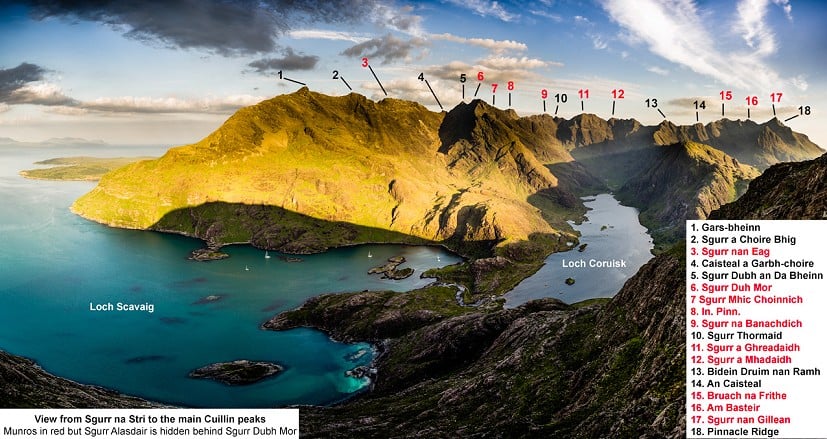
But looked at another way, the challenge is to start on Gars-bheinn and end on Sgurr nan Gillean before descending safely. How you get from start to finish is open to much variation.
Traditionally in summer, the ridge is done south to north and has four principal graded climbing sections:
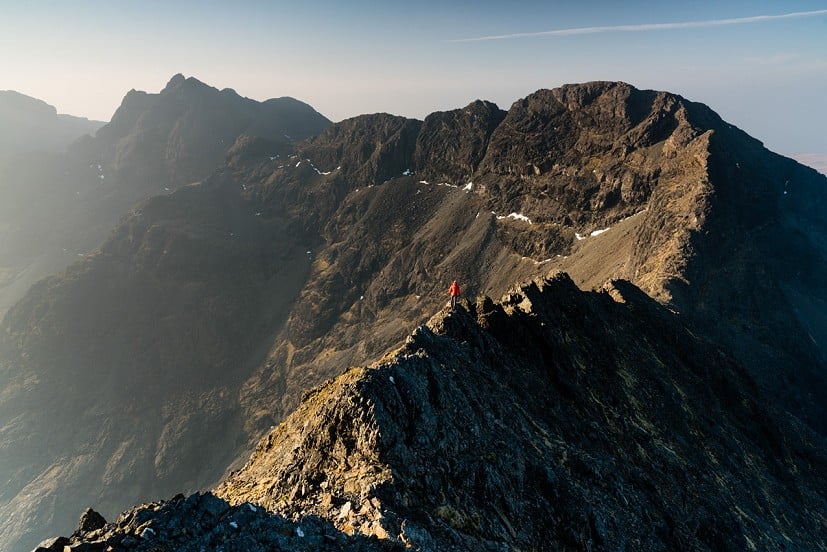
These are not hard grades by modern climbing standards, but a real challenge for non climbers or those with little experience - especially in boots or approach shoes and carrying a pack with bivi gear, food and water.
Even with all the bypasses, the ridge is still a serious proposition, not just physically but also mentally
These climbs have a fearsome reputation and are often described as 'traditional'. In the current SMC guide book, the TD gap sounds innocuous at Severe and only 20m high. But read the description to discover more; "a strenuous classic route that uses most parts of the anatomy to make upward progress at the crux." The description for King's Chimney talks about "passing wedged chockstones with some trepidation." Naismith's Route on the Bhasteir Tooth is described as "a good route in an outrageous position. It is serious when tackled at the end of a Ridge Traverse." Not encouraging, especially if you aren't an experienced climber.
But none of these pitches is obligatory, since all can be bypassed via alternative routes.
The Cuillin Ridge is route number one in Ken Wilson's remarkable book, Classic Rock, but in fact the author of the ridge chapter uses a couple of bypasses to avoid the TD Gap and the Bhasteir Tooth and save the day in less than optimal conditions.
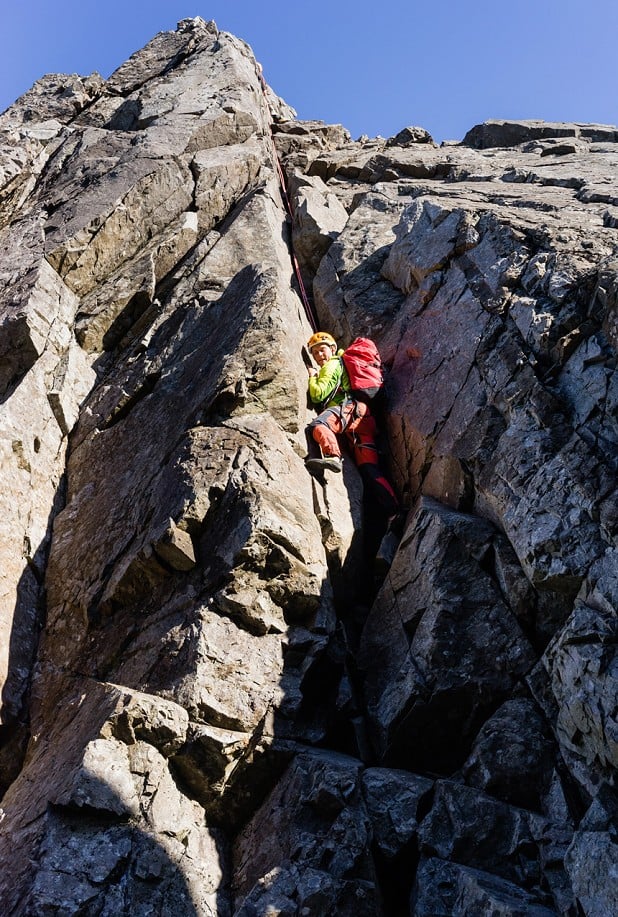
Climbers have long known about these various bypasses, which bring the grade down a bit without interrupting the flow of a traverse. But outside the climbing fraternity, these bypasses may be less well known, so one idea of my new guidebook was to fully document them.
Climbing is contrived; after all, who but a climber would seek out a difficult route when there may be a path to the top? The Cuillin Ridge is the closest the UK gets to an alpine route both in length and quality and it's on a lot of people's wish list, so what are the options for reducing its difficulty and would the resultant "Cuillin Ridge light" still stand up as a route in its own right?
A local guide summed up the ridge traverse as being from "Gars-bheinn to Gillean (or vice versa) with the details of what's include/bypassed up to individual taste or pragmatism. I'd go further and say that including all the Munros is not really essential either – Sgurr Dubh Mor, Alastair and even Am Basteir may require detours which you might not have energy or time for. Basically anything goes unless you're after a record."
Obviously, the purer the line, the better, but finishing on Sgurr nan Gillean and getting down safely for a celebratory drink in Seumas' Bar are priorities. The bypasses might help save the day if the weather turns, and can be put together to produce a still credible ridge traverse. It is possible to follow a pragmatic route that takes the easiest line from the traditional start of Gars-bheinn to finish on Sgurr nan Gillean. You still get miles of the best scrambling in the UK, some abseils, the Munros and can still opt to climb the In Pinn. However, a few of the more technical climbing sections are bypassed by quality alternatives. These bypasses make things easier for those with less experience, and make it easier carrying bivi gear for a two day traverse.
The major bypasses avoiding technical rock climbing pitches are:
1. TD Gap is avoided by traversing screes on the Coir a Ghrunnda side then the SW Flank of Sgurr Alasdair is ascended. Thus, a Severe climb with a notorious reputation is replaced by a Grade 3 scramble. The TD Gap isn't just an awkward climb but can become a bottleneck with climbers struggling to ascend it, perhaps hauling packs which get jammed. This bypass offers an alternative if the Gap is busy.
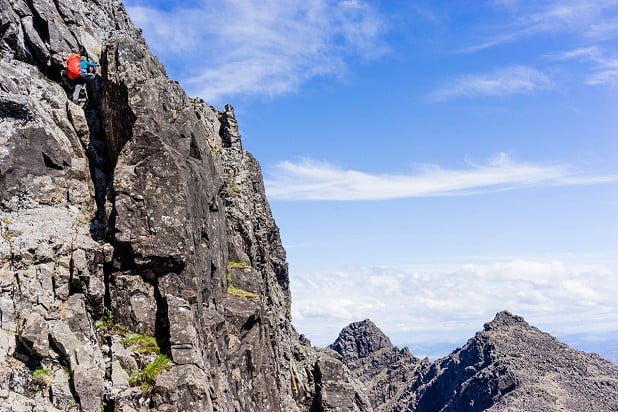
2. King's Chimney can be avoided by the exposed Collie's Ledge. After a couple of Moderate moves to leave Bealach Mhic Choinnich this is a Grade 2 scramble, so far easier than the V. Diff grade of King's Chimney.
3. Naismith's Route is an exposed Severe and coming right at the end of the ridge can seem a huge challenge. Alternatives include Lota Coire Route or bypassing Am Basteir by screes to the north. The latter is quick and easy and Am Basteir can still be ticked by its East Ridge which is an easy scramble except for a couple of moves of Difficult on The Bad Step (but this can be bypassed or abseiled).
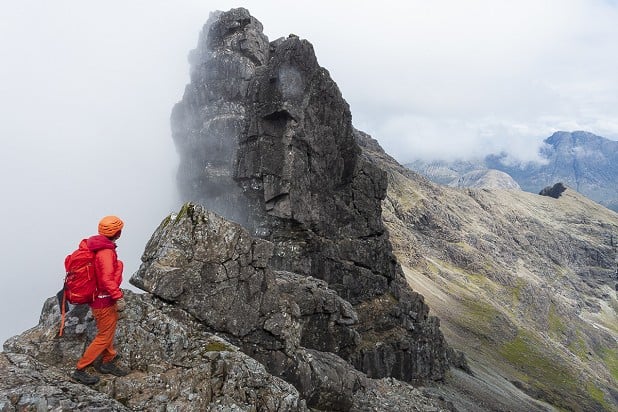
There are lots of other possible bypasses but none really reduce the technical climbing much:
1. An Stac bypass is basically a walk up scree then easy scrambling rather than the serious An Stac Direct with its 250m of exposed Grade 3 scrambling. However this does miss out some of the best and most continuous scrambling on the whole ridge.
2. Bidein Druim nan Ramh can be bypassed completely by traversing screes on the Glen Brittle side, thus avoiding a lot of hard scrambling and two abseils. If time is pressing, bypasses like this can save the day.
3. The In Pinn could easily be bypassed using the slabs on the Coire Lagan side, but the ridge without the Pinn would seem very strange. Not only a classic climb, it's a Munro and every bit as good as the hype. The climbing is Moderate but the crux is only for a couple of metres just below the belay at about half height. Thus, if you are with a more skilled leader, they can keep the rope tight above you and offer advice on the tricky moves. The rest of the climbing is much easier with big hand and footholds, and even bigger exposure.
You've decided to bypass three of the technical rock climbs but opted to tick the In Pinn, so what can you expect from the rest of the ridge? Miles of scrambling, much in very serious and exposed positions. Magnificent views if the weather allows. Yet more scrambling. In total you've got 11 Munros, if the outlying Sgurr Dubh Mor is visited.
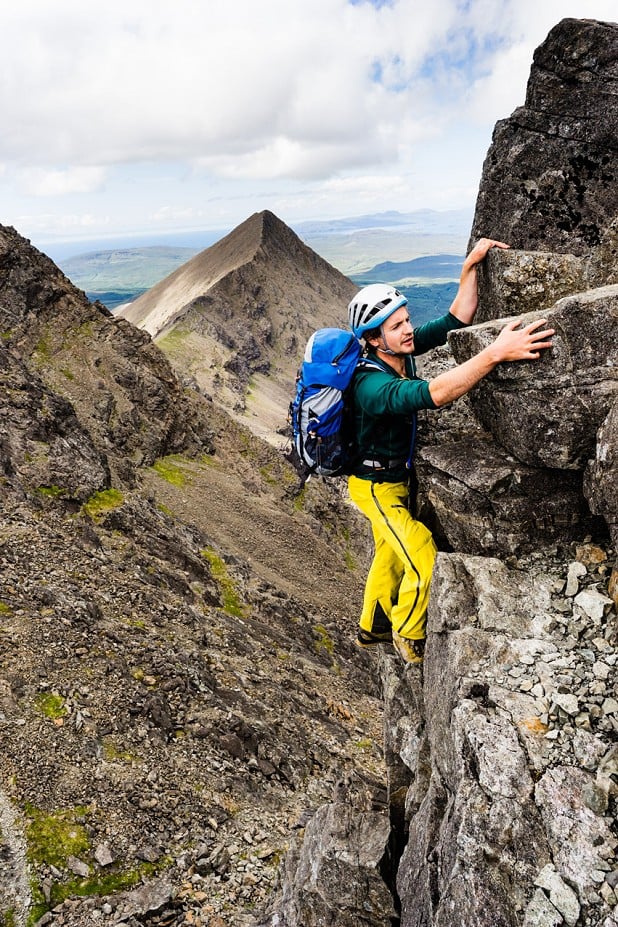
There are still climbing sections where people may well want to be roped up. The hardest section of the ridge with no real bypass is the four tops of Sgurr a Mhadaidh. This will be Moderate with some moves of Diff on the second top. The second top looks steep and intimidating and worse than it actually is. Only the last few metres are hard; they are steep moves but on very good holds and with the possibility of good protection.
Even with all the bypasses, the ridge is still a serious proposition, not just physically but also mentally. The constant need to take care, to be constantly switched on for such a long time on such serious terrain, takes its toll. Lots of the scrambling may not be too hard but there is plenty of scope for disaster if care isn't taken. It's an environment fraught with potential danger and anyone undertaking it must accept the risk. Experience can help reduce the risk but nothing can remove it completely.
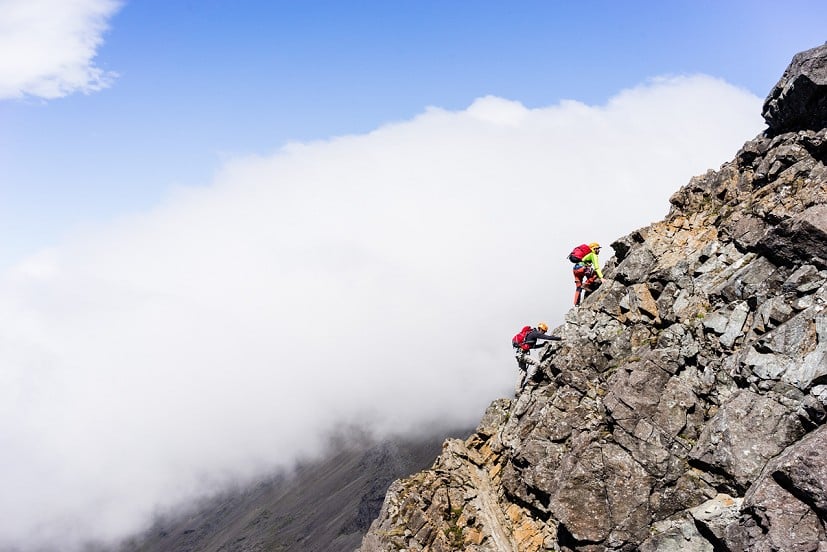
The ridge has risks but the rewards are correspondingly high, so what can you do too maximise your chance of success?
1. Research as much as possible using guidebooks and the internet. Current guidebooks include:
Skye Scrambles by Noel Williams
Skye The Cuillin by Mike Lates
The Cuillin and other Skye Mountains by Tom Prentice
Scotland's Mountain Ridges by Dan Bailey
Rockfax have a useful download which is in the process of being updated
The Cuillin by Gordon Stainforth isn't just a collection of stunning photos but has a useful written description of the ridge. This has long been out of print but is well worth searching out.
You can't have too much information, so read as widely as possible. But more important is getting to know the ridge.
2. Explore the Cuillin and build up to the Traverse. Get to know the different rocks, the weather patterns, get out and check the more tricky sections like the four tops of Sgurr a Mhadaidh or Bidein Druim nan Ramh. It's worth doing the other classic scrambles on Skye, not just to build general familiarity but also because they are stunning in their own right. These include the Round of Coire Lagan, Pinnacle Ridge, the Dubh Ridge, and the traverse of Bla Bheinn and Clach Glas.
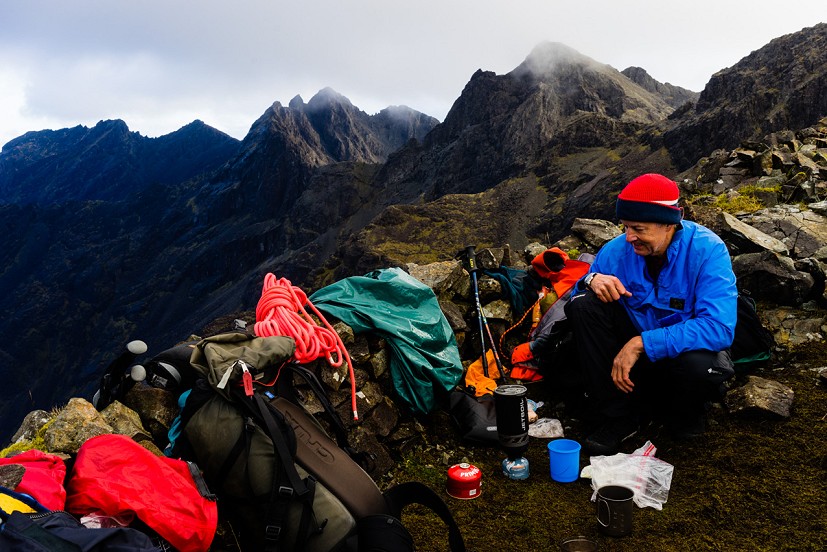
3. Be ridge fit. Practice in the footwear you will be using on the ridge and with a pack on. Get out on long scrambles and climbs, become slick as a team. If possible have plenty of time on Skye not just to increase your chance of a good weather window but to allow for a recce of the ridge and get used to the gabbro and basalt.
4. Only consider the ridge in good weather. Wet rock, especially the basalt, will make things a quantum leap harder. What would be straightforward navigation in clear visibility can become a nightmare in poor visibility. High winds and ridges definitely don't go together.
1. Some of the major difficulties are avoided, thus making it easier especially if doing it over two days and carrying bivi gear.
2. Your team is running out of time/energy or the weather changes. The options may allow you to finish the ridge.
The pragmatic approach is just another tool in your too box, an option to consider either in advance or on the hoof if things change.
Late last autumn this pragmatic approach worked really well for a group I was guiding. Andy was seventy, the days were short and the forecast wasn't ideal. On the plus side, I'd helped Andy and his wife "compleat" their Munros. We'd had some stunning days in the Cuillin and finished on the In Pinn and Sgurr Mhic Choinnich. Andy was an experienced climber with decades of experience and wanted a bigger challenge, while his wife was more than happy just to tick that last Munro.
To maximise our chances of success we deliberately opted for all the bypasses, the easiest possible line would do us just fine. The short daylight hours meant we planned to take three days. Arriving by boat from Elgol, Andy, his climbing partner, Mike and I had a superb three days, certainly one of my best traverses ever despite not doing the technical bits. Andy summed up the traverse succinctly; "it was a very special trip. What more could anyone ask for, great scrambling, magical scenery, mixed weather, great company, a lot of fun and a successful outcome."
Using the pragmatic approach, bypasses either planned or if they prove necessary, you should increase your chances of reaching the end of the ridge. The ridge is always there and a return match can be arranged and a purer line taken. Just remember that this is all very subjective and the only people that it should really matter to are you and your partner. The ridge is something to be savoured, to enjoy, and it is up to individuals to set their goals then work towards them in a safe fashion.
Accommodation Advertise here
No Premier Listings found in this area
Instructor/Guides Advertise here
No Premier Listings found in this area
Outdoor Shops Advertise here
No Premier Listings found in this area
by Adrian Trendall
This two-volume guidebook provides detailed coverage of the iconic Cuillin Ridge, a 12km traverse on the Isle of Skye. Over two volumes, this guide covers everything needed to prepare for and complete a successful traverse over this spectacular ridge. Showcasing the main traverse and the other classic scrambles in the area, both volumes feature official Harvey mapping, numbered topos and corresponding detailed route description.
The first volume provides notes on training, gear and logistics, alongside 10 classic scrambles that can be used as practice routes for the traverse of the whole ridge. This volume also includes in-depth route description and advice for completing the traverse in winter. The second volume focuses on the traverse itself and is the perfect booklet to carry while attempting to complete this renowned scramble. Across ten sections, it explains step by step how to tackle the ridge, as well as providing easier climbing alternatives (Cuillin Ridge Light) for the harder climbing sections.
The ridge can be completed in one or two days. The first volume provides advice about which approach to choose, as well as a list of bivi sites on the Ridge. By also providing an appendix of further reading and useful webcams, this guide offers everything needed to get inspired and get out on the Cuillin Ridge.

Comments
Having guided the ridge many times, taking all or none of the described bypasses on different occasions, I would say an equally great pragmatic consideration for two-day traverses is pre-stashing of bivi gear, food and water (if weather window and schedule allows).
The difference between doing the whole thing with a light pack and a heavy one is huge, and could easily make the difference between having the energy to take more aesthetic direct lines and not. I often find people's bodies and brains are fried by the time it comes to confront the Basteir Tooth, and both Lota Coire Route and the walk around on the screes feel like significant and fairly painful compromises to the line (it's also important to note that taking Lota Coire Route still leaves arguably the hardest moves on the whole ridge to gain Am Basteir).
I'd back what Andy Moles says, regarding pre-stashing gear for a 2-day traverse, and weight. I did it a few years ago with a guide and a friend. We stashed some water, mats, stove etc halfway and it made a big difference. But even then, having missed out the TD Gap on the first day, due to it being wet, we also skipped Naismith's Route at the end, because my friend was knackered. As the author says, it's not just the sheer physicality of the whole thing (inc. a horrible walk-in on a wet dawn, and a chunky walk-out at the end) it's also the mental drain of concentrating so hard all the time. There are few places where you can genuinely walk along simply admiring the views. With the constant exposure you spend so much time making sure where your hands and feet are. After we'd finished my friend and I promised ourselves we'd go back and do it again, just so we could actually try and enjoy it!
PS. If it's wet or damp, take and wear leather gloves. I didn't on the first day and the constant holding onto wet gabbro split 6 of my finger pads. The gabbro also trashed a new'ish pair of synthetic approach boots.
Fried-brain was my exact experience back when I went for a 2-day traverse many years ago... a single day traverse felt much easier (thought I had improved at climbing somewhat)!
I was planning to do a 2 day traverse at the end of May, after getting my better half round some of the more challenging scrambles in North Wales in April. Hoping we get a good September for a go now!
I've got great memories of a September 2 day traverse. If you get the weather, September is a great time to be on Skye, with the ridge usually a good bit quieter than May/June (but perhaps not this year!).